Fiery radiance
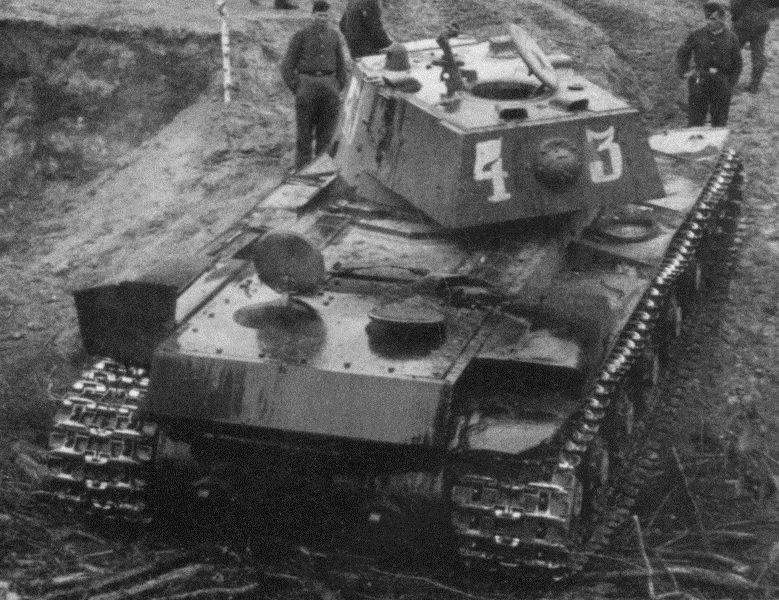
From the author
For a long time the volleys of the guns of the Great Patriotic War died down. Her story described in tens of thousands of books - memoirs of participants and eyewitnesses of those events, official encyclopedias, textbooks and reference books, various historical studies of many modern authors. No less good, especially in the West, are the events of the entire Second World War (although Germany’s military operations on the Eastern Front, where the Soviet Union bore the brunt of the struggle against the Wehrmacht, are usually given very little attention). What unites these two versions of the presentation of the events of one, in fact, war is that a large proportion of books and historical studies are devoted to 1942. This year really deserves such attention - it accounts for such significant victories of the Axis countries as the breakthrough of the German army to the Volga and the Caucasus on the Eastern Front, and in Africa to Tobruk and the approaches to Cairo, the seizure of Malaya and Singapore by Japan, with the subsequent establishment Empire control of the Rising Sun over much of the Pacific Ocean. At the same time, it was this year that marked the beginning of a radical change in the Second World War - starting from the loss of the Imperial Japanese fleet its main striking force - four heavy aircraft carriers with almost all the crews in the battle at Midway Atoll and the defeat of Rommel near the invincible “African Corps” near El Alamein, before the death of the 3rd Romanian and 8th Italian armies on the Don, as well as the full encirclement of the 6th German army near Stalingrad.
If we talk strictly about the Great Patriotic War, the bloody battles that took place in 1942 on the southern part of the Soviet-German front - Kharkov and Voronezh directions, in the Crimea and the foothills of the Caucasus, near Stalingrad and in Novorossiysk, were largely decisive for the general the outcome of the confrontation of the USSR and Germany. The value of those battles is hard to overestimate. However, they largely “obscured” other 1942 battles of the year, which also, if viewed objectively, made no less decisive contribution to the strategic defeat of the German army in the south of the Eastern Front, and in general to the radical change in the course of the entire war. One of these, not so widely known as the battles on the banks of the Volga or on the passes of the Caucasus, will be discussed in the pages of my book, with several chapters from which I want to introduce visitors to the Military Outlook website.
It will be a question of the summer-fall fighting of 1942, when the German High Command no longer wanted to put up with the fact that almost a third of the German ground forces on the Eastern Front were tied into positional battles near Leningrad. Not having achieved the extermination of the city by hunger, Hitler decided to throw additional forces near Leningrad, so that, finally, having achieved the capture of the city and united in the north with the Finnish troops, to release the lion's share of his divisions who fought in this direction. Having thus secured a decisive advantage on the northern front of the Soviet-German front, Hitler could have succeeded in September 1942. either move to Moscow from the north, by consistently crushing the North-Western and Kalinin fronts, or by transferring the liberated divisions to Stalingrad or the Caucasus, finally decide in their favor the outcome of the struggle for the oil-bearing region so vital for warfare. The Soviet command, in turn, after an unsuccessful attempt to unblock Leningrad in the spring of 1942, did not set aside plans to break through the land corridor to Leningrad. As a result, when the Supreme Command gave orders to the troops of the Leningrad and Volkhov fronts to prepare for the next offensive operation, no one could assume that this regular attempt to lift the blockade would result in a counter battle with the enemy prepared for the final assault.
Creating a book, I was based mainly on the memories of participants of those years and documents that are publicly available. However, in the plot of this work, I allowed myself some artistic processing, but only to the extent that does not distort the historical accuracy of the narrative. For a more visual description of the events, in my book I used a lot of photographs taken at that time, on both sides of the front. In most cases, I found them on various websites and forums that now exist on the Internet and, unfortunately, I have not always been able to determine who took such pictures, as well as who is depicted on some of them. In this regard, I express my deep gratitude to all their authors and those who kept and placed these materials.
Defenders and defenders of Leningrad, as well as all those who in those difficult years of defense and blockade of the city made so much effort, not sparing their strength and lives, to help the residents and warriors of the city on the Neva to escape from the clutches of hunger and death a strong enemy, my book is dedicated ...
Fighters for the freedom of Leningrad,
I dedicate this book
CHAPTER 1. HEROIC SEVASTOPOL
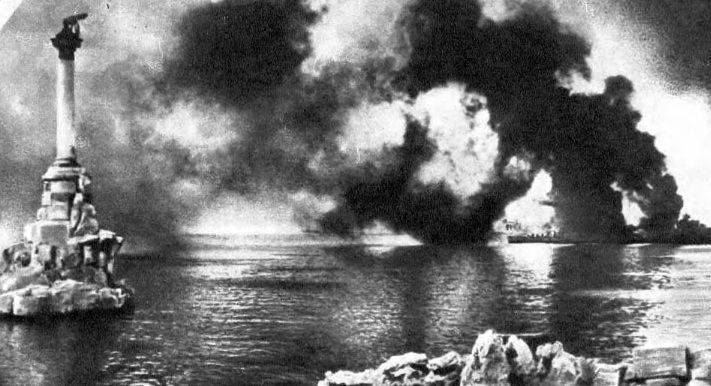
1 July 1942.
Tatar house in Yukhary-Karales (Crimean peninsula)
Command Post 11 of the German Army
The commander of the 11 German Army, Colonel-General Erich von Manstein, was looking at the battlefield dying before him. In the north-west, the woodland was visible, which had recently concealed battles on the left flank of the 54 Army Corps, which dealt the main blow in the operation, codenamed “Sturgeon Fishing”. There, on the heights to the north of the eastern tip of the North Bay, the corps suffered the most severe losses in the battles against the troops of the IV Sector of Russian Defense, supported by the large-caliber guns of the Fort Maxim. Only having crushed this resistance, the troops finally managed to reach the coast and cut off the main supply line of Sevastopol - no vessel could enter the port anymore. The Gaitanian heights, which were visible in the west, partially covered the glittering surface of Severnaya Bay at its junction with the Black Sea. In the south-west, the heights of Sapun Mountain rose menacingly and the coastal cliffs towered. In the distance, one could even distinguish the tip of the Chersonese peninsula, where Soviet troops were still trying to continue resistance, which, according to the German commander, was already meaningless. The fate of the defense of Sevastopol was finally decided in the last days of June, after the successful crossing of the 54 Army Corps across Severnaya Bay, the fall of Inkerman Heights and the subsequent breakthrough of the 30 Army Corps Sapun position.
The mood in the headquarters of the 11 th army was upbeat. Finally, after almost a year of tough fighting, the Crimea and the Kerch Peninsula were almost completely conquered. And although the remnants of the coastal army retreated and tried to organize another defense line on the Chersonesus peninsula, it was clear to the Germans that the fall of this last frontier was a matter of a few days (1).
(1) - the fighting on the Chersonesus Peninsula lasted until July 4, the remnants of the seaside army were captured.
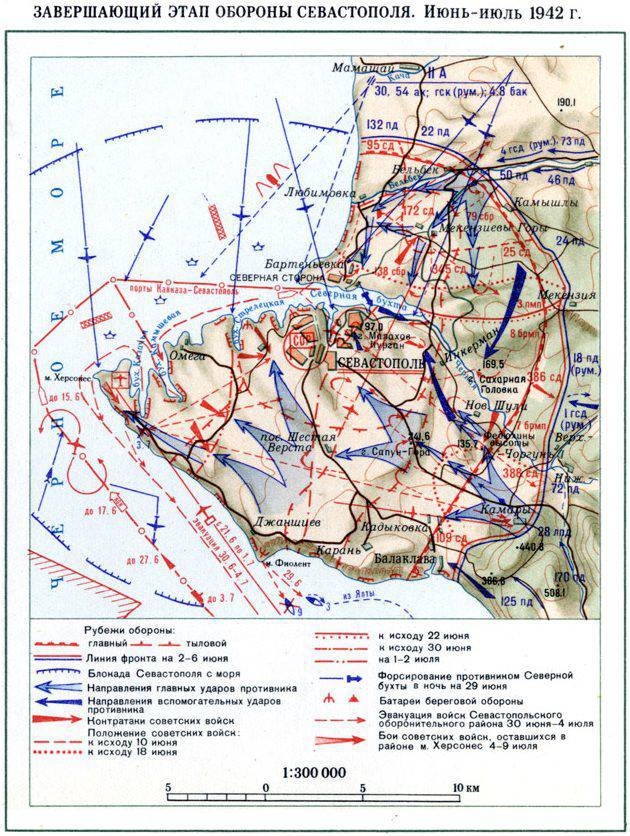
In the air, there was the sound of the engines of planes taking off from the nearest airfield. Squadron Ju-87, gaining altitude, took a course to the northeast. These were airplanes that belonged to the 8 of the Wolfram von Richthofen air corps.
“It’s a pity to part with our little birds,” Manstein said, turning to the nearby staff officers. “They helped us a lot here, but now they will most likely be von Bok on the Don and the Volga (2).
(2) - The German 8th Air Corps provided very tangible, if not decisive, support to Manstein's troops during the last assault on Sevastopol. In addition to the direct bombing of the defensive positions of the Soviet troops, on which the air corps spent more than 20 thousand tons of bombs, the planes attacked the ships and submarines of the Black Sea Fleet, significantly complicating the supply of the surrounded city and preventing the use of fleet ships for effective artillery support of their ground forces. After the capture of Sevastopol, the 8th Air Corps will be tasked with actively cooperating with the 6th Army of Paulus, where he will have to pave the way to Stalingrad with his heavy bombs.
Returning to the army headquarters, Manstein found several officers there who could easily discuss whether they could get a well-deserved rest in the near future and spend a week or two on beautiful Crimean beaches.
“In this wonderful area of the Southern Crimea, wonderful fruits have already ripened - they are the best suited to the wine that local people can do very skillfully,” remarked Major Eisman with undisguised anticipation, imposingly leaning back in his chair. - Add to this the wonderful climate and the beauty of nature - our vacation promises to be just great!
“Gentlemen, turn on the radio soon!” - The voice of the duty officer caused a lively response from several people who immediately rushed to the radio.
From the speaker came the sounds of triumphant fanfare.
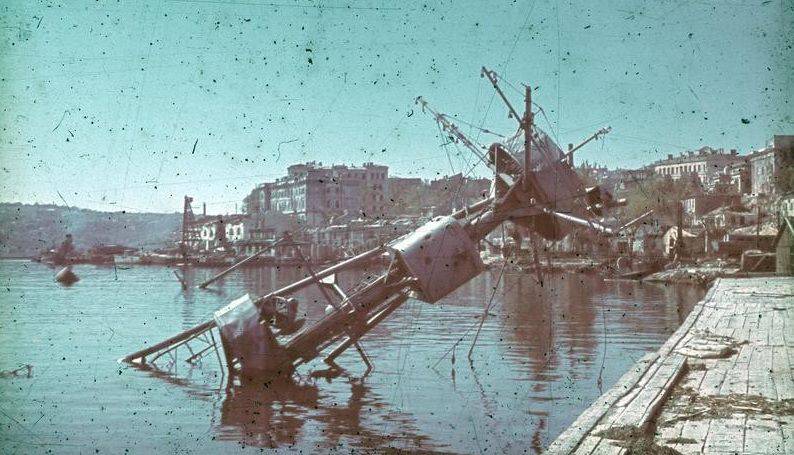
The sunken cruiser Chervona Ukraine at the Count's pier of Sevastopol. On November 8, 1941, he was the first of the ships of the Black Sea squadron to open fire on enemy troops advancing on the city, he was one of the first victims of the German aviation during the first assault on the city.
- ... today, 1 July 1942g. The valiant German troops of the 11 Army completely captured the last Russian stronghold in the Crimea — the fortress of Sevastopol! - the voice of the announcer sounded proudly and solemnly.
Manstein, surrounded by staff officers, also listened to the announcement of his victory. Suddenly an agitated adjutant of the commander, Chief Lieutenant Specht, rushed into the room.
- Mr. Colonel-General! - he blurted out excitedly, - you urgent telegram from the Fuhrer!
- Read! - commandingly said Manstein.
“To the commander of the Crimean army, Colonel-General Erich von Manstein,” Specht’s voice was still trembling a little with excitement. - With gratitude, noting your special services in the victorious battles in Crimea, which culminated in defeating the enemy in the Kerch battle and seizing the powerful Sevastopol fortress, famous for its natural obstacles and artificial fortifications, I assign you the rank of Field Marshal. By assigning you this rank and the establishment of a special sign for all participants of the Crimean battles, I pay tribute to the entire German people to the heroic deeds of the troops fighting under your command. Adolf Gitler.
The officers rushed to congratulate the commander. Manstein, accepting congratulations, announced his intention to celebrate this event:
- Tell the troops that after the end of the suppression of the last Russian centers of resistance, I will invite to the solemn meeting all the commanders, up to the commanders of battalions and all noncommissioned officers and privates who have the Knight's Cross or Golden German Cross and congratulate them on the successful completion of our Crimean campaign ...
A few days later, 5 July 1942, the evening dawn sounded in the park of the former royal Livadia Palace. There was a drum roll. which was replaced by a short prayer service for German soldiers who had already been buried in the Crimean land. The meeting was headed by the commander of the 11 of the German army, who, too, praying, humbly bowed his head, thus paying tribute to the memory of those who had died.
At the end of the prayer service, Manstein addressed the audience:
- My glorious comrades! The fortress, protected by powerful natural obstacles, equipped with all possible means and defended by a whole army, fell. This army was destroyed, the whole Crimea is now in our hands. Losses of the enemy in manpower surpass ours several times. The number of captured trophies is huge. From an operational point of view, the 11 Army was freed just in time for use in the large German offensive that began on the southern sector of the Eastern Front, - Manstein paused and continued: - I thank all the 11 Army soldiers and 8 air pilots corps, as well as all those who could not participate in this celebration, for their dedication, courage and resilience, often manifested almost in a critical situation, for everything they did in this ...
The low hum of approaching aircraft interrupted Field Marshal's speech. All those present turned on him, and, as if on cue, rushed scatter. The whistle of the falling bombs and the powerful explosions that followed it badly spoiled the German holiday. Having described a few more circles in the sky, apparently evaluating the results of the bombing, Soviet aircraft began to move away towards the Caucasus - their silhouettes slowly dissolved in the rays of the sun which was beginning to decline, and the sound of the motors brought by gusts of warm summer wind gradually began to calm down. Manstein, adjusting his uniform and making sure that the danger had passed, again addressed the commanders present:
“Despite today's victory, the war is not over yet, gentlemen,” Manstein’s voice was relatively calm, but a new shade appeared in it, after this air attack, betrayed the doubts of the field marshal. It seems that now everything was going well, but this prolonged military campaign in the east still brought too many unpleasant surprises. The Russians stubbornly refused to admit their defeat, and this sometimes made one wonder whether the Germans were too optimistic about the outcome of this confrontation with the USSR. However, quickly taking himself in hand, the field marshal tried again to make his voice firm and confident, and then ended his speech with the words:
- We need to prepare for new battles, which will certainly lead us to the final victory! Heil Hitler!
The crowd gathered field marshal triple "Sieg Heil!" The officers looked at their commander with admiration, and most of them were already beginning to feel the victorious euphoria of the events of the last days. On the southern flank of the Eastern Front, the German army, which finally recovered from the winter defeat near Moscow, inflicted a heavy defeat near Kharkov and Barvenkovo on Soviet forces in May 1942. June 28 German troops launched a broad offensive in the Voronezh sector, striking from the Kursk area on the 13 and 40 armies of the Bryansk Front. 30 June from Volchansk area launched an offensive in the direction of Ostrogozhsk 6-I German army, which broke into the defense of 21-th and 28-th armies of the Soviet troops. As a result, the defense at the junction of the Bryansk and South-Western fronts was broken through to a depth of eighty kilometers. The German assault forces created a threat of a breakthrough to the Don and were preparing to seize Voronezh. Thus, the German Army Group "South" (later divided into Army Groups "A" and "B"), began its decisive attack on the Caucasus and Stalingrad. Now, after the complete conquest of the Crimea, the German commanders thought that the Russians had no chance to repel the Wehrmacht’s summer offensive, which very soon would bring them the final victory on the Eastern Front.
It was getting dark ... On the alleys of the Livadia Palace Park, muffled enthusiastic toasts were heard for the victory of the 11 army, the health of the Fuhrer and Great Germany - they were accompanied by the tinkling of glasses and merry exclamations. Only a few elderly officers, gathered in small groups a little bit away from the already heated young colleagues, discussed the recent desperate resistance of the Russians on the Chersonese Peninsula. At the same time, many of them frowned anxiously, realizing that the war was indeed far from “over” ...
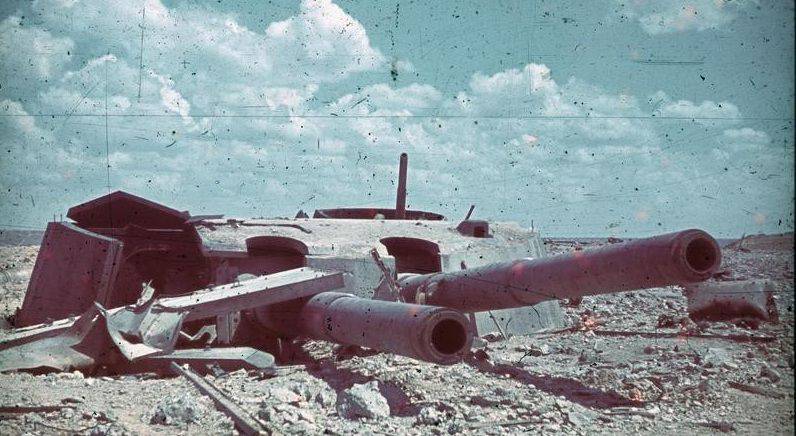
The ruined tower of the 30 battery, nicknamed by the Germans as the fort "Maxim Gorky - 1". Her 305-mm guns inflicted heavy losses on parts of the Wehrmacht 54 Army Corps rushing to the North Bay of Sevastopol. The Germans were able to destroy the surviving battery defenders and completely capture it only 26 June 1942g. The commander of the battery guard, Major G.A. Alexander was taken prisoner, where he was shot for refusing to cooperate with the Germans.
CHAPTER 2. LYUBAN BAG
Outside the window of the car of the commander of the Volkhov front, Army General Kirill Meretskov, stretched, seemingly endless, marshy swamps. The car now and then jumped up and down the broken road and abruptly tilted, with its forced maneuvers on its winding path.
“Do you even slow down the speed on these bumps,” Meretskov addressed his chauffeur.
“Kirill Afanasyevich, there are such holes and bumps everywhere,” turning around, the driver said to the commander, though somewhat guilty.
The general did not answer, looking thoughtfully out the window, behind which a monotonous picture seemed frozen. Looking at the events of the last month, he seemed to relive them ...
8 June 1942.
Western Front.
Command post 33-y army.
The call to the field phone sounded unexpectedly. The army commander picked up the phone:
- Commander-33 Meretskov at the unit, - he introduced himself.
At the other end of the line, the familiar voice of the commander of the Western Front, GK, was heard. Zhukov.
- Hello, Kirill Afanasyevich. You need to urgently arrive at the front headquarters, ”he ordered, as always, briefly and firmly.
- Good morning, George Konstantinovich! I’ll take a card and come, thinking that the discussion will deal with the operation being prepared by the 33 Army, Meretskov replied.
“You don't need a card,” said Zhukov sharply.
- Yes, then what is the matter? - puzzled, asked the commander.
“You will find out here.” Hurry up!
After a while, still wondering about the purpose of the urgent call, Meretskov entered Zhukov’s office. He sat at his desk, frowningly dismissively and examining some paper. The incoming army commander reached over and prepared to report his arrival:
“Comrade commander of the Western Front ...” he began.
Zhukov, sharply lifting his head, interrupted him.
- Well, where do you carry, Kirill Afanasyevich? I could not find you for almost two hours!
- Georgy Konstantinovich, was with the soldiers in the battalion. Arrived immediately from there, did not even have time to eat. And then your call.
“The Supreme has already called me three times.” Urgently demands your arrival in Moscow. The car will be prepared for you now, but for now we will have something to eat with you.
- And what is the reason for the call? - again tried to learn Meretskov.
“I don’t know,” Zhukov looked away. - Order - urgently arrive at the Supreme. It's all…
Half an hour later, a car with the commander of the 33 Army flew along the night road to Moscow. At two o'clock in the morning he entered the reception room of the Supreme Commander. He was met by, smiling, Stalin’s secretary, A.N. Poskrebyshev.
- Hello, Kirill Afanasyevich! - He quickly said hello. - Come in, the Supreme is waiting for you.
- Good morning, Alexander Nikolaevich! - answered Meretskov. - Allow me at least to put myself in order - I arrived right from the front line, I did not even have time to change clothes.
- Come on, come on, - Poskrebyshev objected, - Joseph Vissarionovich has already asked about your arrival more than once, the question, apparently, is very urgent.
Meretskov entered the office. In the large room, at the head of a huge table, sat the Supreme Commander. In Stalin’s hand was his famous pipe, on the left and right sides of him were L.P. Beria, G.M. Malenkov and A.M. Vasilevsky.
- Comrade Supreme Commander, Commander of the 33-th Army of the Western Front arrived at your order! - clearly reported Meretskov.
Stalin looked at the commander’s clothes with some surprise — numerous dried out traces of dirt were visible on the field uniform, the boots looked as if they were kept in cement mortar for a long time. Other participants also appraised Meretskov’s clothes.
“I beg your pardon, Comrade Stalin,” said the commander, embarrassed. - I was called to you directly from the trenches of advanced positions.
- Go and clean up. I give you five minutes, ”Stalin said harshly, as if piercing him with his eyes.
Quickly cleaning his boots, after five minutes Meretskov again entered the office. This time Stalin’s eyes looked at him more cordially.
“Come in, Cyril Afanasyevich, you can sit down,” the Supreme One invited him to the table. - How are you doing on the Western Front? - Stalin asked.
- We conducted training for officers, forging team teams, improved the defense system. We receive and study new equipment, conduct thorough acquaintance with the terrain, prepare combat lines. We are working on coordinating action plans with front-line aviation and artillery, “we are running” personnel in the conditions of an “enemy” attack, we are organizing interaction on the flanks with our neighbors, we are creating reserves ... - Meretskov reported in detail about his work.
“This is good,” said Joseph Vissarionovich with his familiar Caucasian accent, making special emphasis on the last word. - But I called you here today, on another issue.
Rising from his seat, Stalin slowly walked along the table, puffing on his pipe. Looking somewhere in front of him, he seemed to be thinking out loud:
“We made a big mistake by uniting the Volkhov front with the Leningrad front. (3) General Khozin, although he was sitting on the Volkhov direction, was doing poorly. He did not comply with the Bids directive on the withdrawal of troops of the 2 th shock army. As a result, the Germans managed to intercept the communications of the army and surround it. You, Comrade Meretskov, - after a pause, the Supreme continued, turning to the commander, - you know the Volkhov Front well. Therefore, we instruct you, together with Comrade Vasilevsky, to go there and by all means rescue the 2 th shock army from the environment, even if without heavy weapons and technology. The directive on the restoration of the Volkhov Front will be obtained from Comrade Shaposhnikov. You should, upon arrival at the scene, immediately join the command of the Volkhov front ... (4)
(3) - On April 23, 1942, a decision was made by the Headquarters of the Supreme High Command to transform the Volkhov Front into the Volkhov Operational Group of the Leningrad Front. K.A. Meretskov, who until that moment had held the post of commander of the Volkhov Front, was transferred to the post of Deputy Commander-in-Chief of the Western Direction, G.K. Zhukov. Soon, at his own request, K.A. Meretskov, he was transferred to the post of commander of the 33rd Army of the Western Front.
(4) - Simultaneously with the restoration of the Volkhov Front and the appointment of K.A. Meretskov, by the Order of the Headquarters for the untimely withdrawal of the troops of the 2nd shock army, Lieutenant General Khozin was removed from the post of commander of the troops of the Leningrad Front and appointed commander of the 33rd Army of the Western front. Lieutenant-General L.A. will soon become the new commander of the Leningrad Front. Govorov.
Fulfilling an order, on the same day K.A. Meretskov and A.M. Vasilevsky left Moscow. By evening, they arrived at the Volkhov front, in Malaya Vishera. Having collected the staff officers, the new front commander and a representative of the Stavka immediately began to discuss the current situation at the front.
The new commander of the Volkhov front turned to the chief of staff of the front, Major General GD. Stelmakhu:
- Grigory Davydovich, I ask you to report on the situation on the front of the 2 shock, 52 and 59 armies, as well as your thoughts on the measures that need to be taken to ensure the restoration of the communications of the 2 shock army and the implementation of the Stavka’s decision on its conclusion from the environment.
The chief of staff approached a large map hanging on the wall and began a report.
- As you know, according to the Supreme Command Directive No. 005826 of 17 December 1941 of the year, our front was ordered to launch a general offensive, with the aim, in cooperation with the Leningrad Front, to smash the enemy defending the west bank of the Volkhov River. To accomplish this task, the troops of the front, as part of the 4, 59, 2 shock and 52 armies, had to break through the enemy front and leave the main forces of the army on the Lyuban line, Art. Cholovo. Subsequently, according to the Directive, the front forces were to advance in the north-west direction, where, in cooperation with the Leningrad Front, they would encircle and destroy the grouping of German forces defending near Leningrad. - he showed on the map the direction of the planned attacks then.
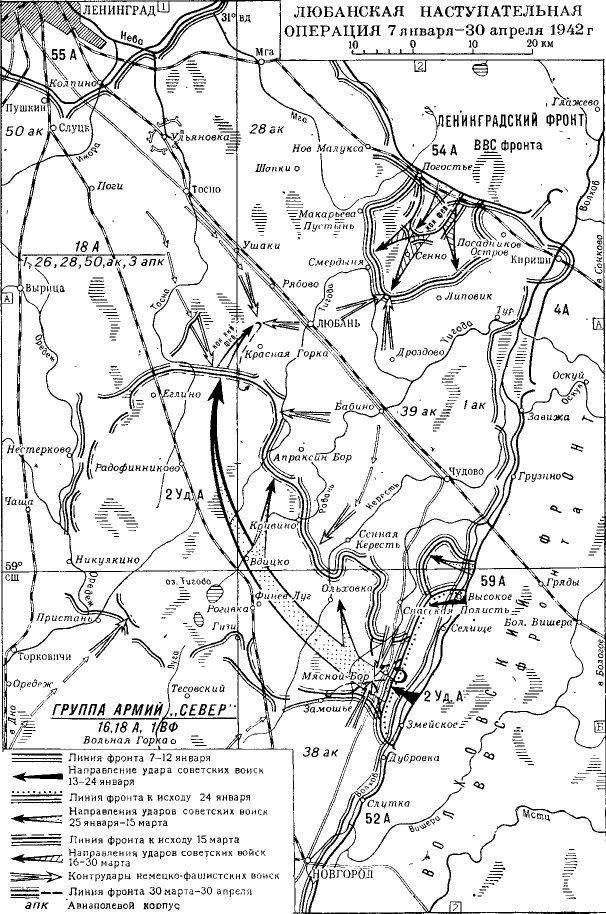
“The 54 army units were supposed to interact with us from the Leningrad Front,” the speaker continued. “As a result of the offensive that began on January 7, our armies managed to achieve only a slight advance in 15 days - the 2 shock army that dealt the main attack, as well as the 59 army, were able to advance only 4-7 kilometers. Equally insignificant successes were at the 54 Army of the Leningrad Front. The fighting took a heavy protracted nature, the troops suffered heavy losses, many divisions and brigades had to be withdrawn to the reserve and replenished. After the resumption of the offensive in late January - early February, the troops of the 2 shock and part of the forces of the 59 armies managed to break through the enemy front and penetrate to the depth of 75 km during February. February 28 The General Headquarters ordered our 2 Shock Army and the 54 Army of the Leningrad Front to advance towards each other and unite in Lyuban, with the aim of encircling and destroying the German-Luban group of forces, and advancing on Tosno and Siverskaya with this task the purpose of eliminating the enemy’s MGN grouping and lifting the blockade from Leningrad. However, soon the advance of the 2 shock and the 54 armies choked, our troops stopped before reaching Lyuban 10 — 12 km. The German command, understanding how it could threaten the further advancement of our troops in the direction of Lyuban, decided to proceed to active operations. Pulling off fresh units, including the SS infantry and police divisions, to the breakthrough site, they directed them against our troops, who provided the communications for the 2 shock army in the area of the highway and railroad Chudovo-Novgorod. The units of the 59 and 52 armies defended there, suppressed by powerful artillery and mortar fire and aircraft, could not withstand the onslaught of the enemy. March 19 The Germans managed to close the neck of our penetration four kilometers west of Meat Bor, and thereby cut off the communications of the 2 shock army. By March 26, the enemy succeeded in combining his Chudov and Novgorod groups, creating an external front along the Polist River and an internal front along the Glushitsa River - Stelmach made a short pause so that those present could refresh their memory of the events of those days.
Meretskov, who had listened attentively to the report, nodded in approval, thus suggesting that the Major General continue.
- To liquidate the troops that interrupted the communications of the 2nd shock army, the Volkhov Front involved 3 rifle divisions, two separate rifle and one tank Brigade, the Headquarters requested the necessary replenishment for the troops of the front with people and equipment. As a result of the measures taken, on March 30, 1942, as a result of heavy bloody battles, our troops managed to make a breakthrough to the encircled troops. However, the width of the corridor that was pierced by them did not exceed 1,5–2 km. In such a narrow corridor only small groups of soldiers, individual guns and carts could move, and even then only at night. Thus, in essence, the communication of the 2nd shock army was not fully restored. Almost surrounded by eleven rifle and three cavalry divisions, five separate rifle and one tank brigade. In this regard, the Military Council of the Leningrad Front and the Volkhov Group on April 30 ordered the 2nd Shock Army to go on the defensive, and then begin to withdraw (through the existing passage of the 13th Cavalry Corps) four rifle divisions, a tank brigade, all wounded and sick soldiers, as well as what troops from the rear institutions do not need. As a result of the measures taken, by May 16, 1942, when the roads and column roads dried up, the 13th cavalry corps consisting of three cavalry divisions, the 24th and 58th rifle brigades, the 4th and 24th I am the Guard, the 378th Infantry Division, the 7th Guards and the 29th Tank Brigades. By June 1, the 181st and 328th rifle divisions, an army-type artillery regiment of the army type were additionally withdrawn, all wounded soldiers were removed, and surplus property was evacuated. - G.D. Stelmakh paused again. “However, the German command was not idle,” he continued. - Strongly owning the area of Spasskaya Polisti and the ledge southwest of this point, as well as the Lyubtsy area, it constantly threatened to interrupt the passage, 1,5-2 km wide in the area of Myasniy Bor. Having deployed the 121st and 61st infantry divisions in addition to the forces there, the enemy went on the offensive on May 30 and substantially narrowed the neck of the bag until June 4. On June 5, going towards the 2nd shock army, our 59th army struck. But the Germans meanwhile crushed the battle formations of the 2nd shock army and burst into them from the west. And on June 6, they again completely blocked the neck of the bag. Surrounded by parts of seven rifle divisions and six rifle brigades, with a total number of up to 18-20 thousand people.
- So, what is planned by the front headquarters to correct the situation? - asked A.M. Vasilevsky.
“In order to counter the enemy, we have planned one more blow to meet the forces of the 59 Army leaving the encirclement,” answered the front line head of Vasilevsky and showed the direction of the blow on the map.
- What forces do you plan to deliver this blow? - entered the discussion Meretskov.
“Since there are no reserves for our front, we plan to free three rifle brigades and a number of other units from various sectors of the front, including one tank battalion. These forces, combined into two groups, must pierce a corridor wider in 1,5 - 2 km, cover it from the flanks and ensure the exit of troops of the 2 th shock army. This kick can be organized by 10 Jun. - finished GD Stelmach ...
As if having awakened from his memories, Kirill Meretskov again looked out the window of the car, at the deserted marsh landscape. Since that meeting with the front headquarters, three and a half weeks have passed. During this time, the Volkhov Front made several attempts to reach the surrounded troops of the 2 shock army. Only 21 of June by joint strikes of the 59 and 2 of the shock armies managed to break the encirclement by a width of about 1 km. In the formed passage to the 20 watch, 22 June came out of the environment around 6 thousand people. By June 23, the area occupied by the 2 shock army had shrunk to such proportions that it had already fired at enemy artillery to the full depth. The last site, on which food and ammunition were dropped by airplanes, was taken over by the enemy. June 24 communications with the headquarters of the 2-th shock army finally broke off. The enemy again broke through the front at the main turn of its defense in the Finev Luga area and began to develop an offensive along the railway and narrow-gauge railway in the direction of New Kerest. In the morning of June 25, the exit from the environment completely stopped ...
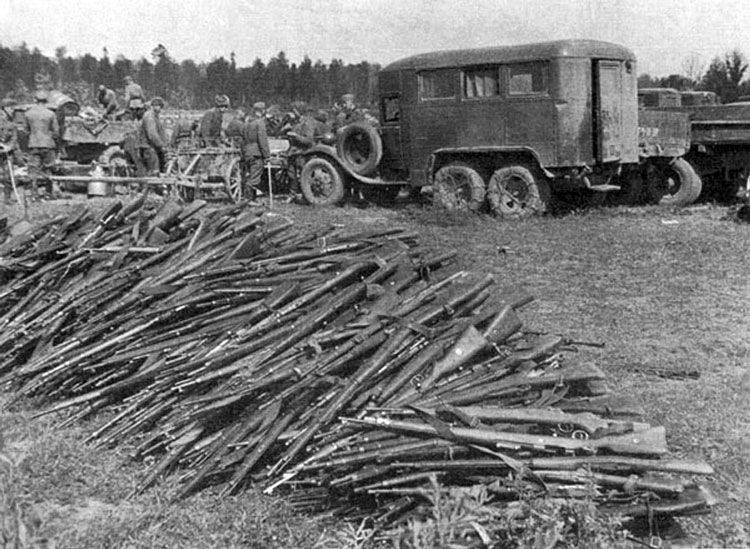
One of the warehouses of trophy property collected by the Germans as a result of encirclement and defeat of the 2 th shock army in the Luban operation.
The thoughts of the commander were contradictory. “So, the heavy Luban operation has just ended,” he thought, peering into the peat fields flooded with water. - The operation ended very badly, most of the 2 shock army died in the boiler under the Meat boron, only 8-9 thousand people without heavy weapons could be removed from the environment, but these soldiers and officers were completely exhausted. However, the front forces during the entire Luban operation forced the enemy to conduct heavy defensive battles, inflicted considerable losses on the Germans and hampered more than 15 enemy divisions, including one motorized and one tank division, with two infantry divisions and a number of individual units the enemy was forced to withdraw directly from Leningrad. To counteract our offensive and compensate for the heavy losses, in the first half of 1942, the German command was forced to strengthen the Army Group North with six divisions and one brigade. But, nevertheless, the main task - the lifting of the blockade of Leningrad - is still not fulfilled, and it is impossible to delay in this. In the very near future, it is necessary to submit proposals to the Supreme Command Headquarters for a new offensive operation. The remnants of the 2 Shock Army, allotted to the rear for re-formation, will soon again have to go into battle ... "
- What are you going like a turtle, press come on, time is running out! - sharply ordered Meretskov to the driver, finally driving off dark thoughts from himself.
Perplexedly glancing at the general, the soldier shrugged his shoulders and pressed the gas - the car obediently added speed, not forgetting to bounce on bumps and bumps even higher ...
Information